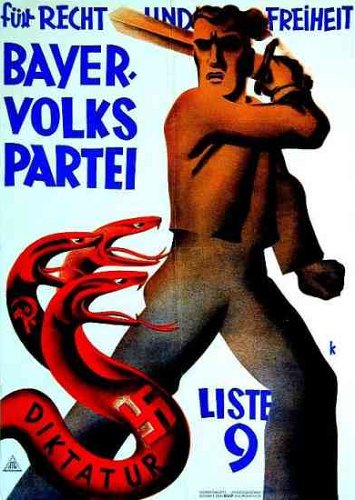Germany
About Andrew Cusack
 Writer, web designer, etc.; born in New York; educated in Argentina, Scotland, and South Africa; now based in London.
Writer, web designer, etc.; born in New York; educated in Argentina, Scotland, and South Africa; now based in London. read more
News
Blogs
Reviews & Periodicals
Arts & Design
World
France
Mitteleuropa
Knickerbockers
Argentina
The Levant
Africa
Cape of Good Hope
Netherlands
Scandinavia
Québec
India
Muscovy
Germany
Academica
Herbert Ritter von Karajan: 1908-1989
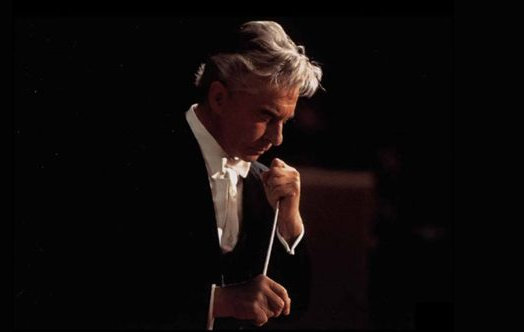
Saturday was the one-hundredth anniversary of the birth of the brilliant Herbert Ritter von Karajan of Salzburg, conductor of the Berliner Philharmoniker for thirty-five years. There is a famous (and probably apocryphal) anecdote of Karajan leaping into a taxicab and, when being asked as to his destination, replying “No matter. I am in demand everywhere.” He is of course very well known for his Wagner, but here we present the latter half of Beethoven’s Symphony No. 9: (more…)
The Rathaus of Gladbeck
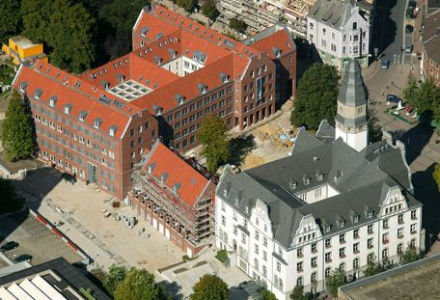
JUST SO YOU ARE aware that not all the architects hate us, let us travel to the Westphalian town of Gladbeck where the city fathers, in their infinite sagacity and wisdom and ever open to changes in inclination, have seen fit to correct the errors of the not-too-distant past by tearing down two hideous concrete boxes and replacing them with a more appropriate annex to the handsome art-nouveau Rathaus (town hall). The man to thank, apparently, is Gladbeck’s Stadtbaurat (town planning advisor) Herr Michael Stojan (a tweedy sort of fellow, it appears), who initiated the project. What a pity the directors of the Morgan Library could not exercise a similar wisdom.
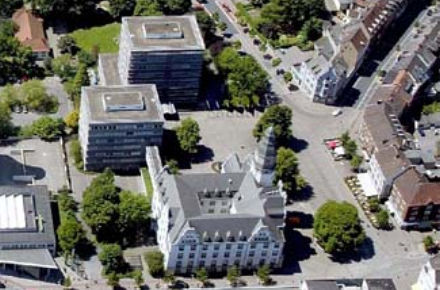
Gladbeck’s ‘Willy Brandt Platz’ before the offensive structures were removed.
The new building is modern but not modernist, and has no pretensions to being the original Rathaus’s contemporary. It exhibits a certain simplicity, and while it lacks exterior ornamentation it does not suffer much from that absence. Internal courts provide natural light to the offices within, while arcades offer shelter to passers-by in the event of an impromptu opening of the heavens. With its saddleback gables, the annex complements but does not compete with the town hall it is intended to augment. Improvements such as this are deserving of our applause.
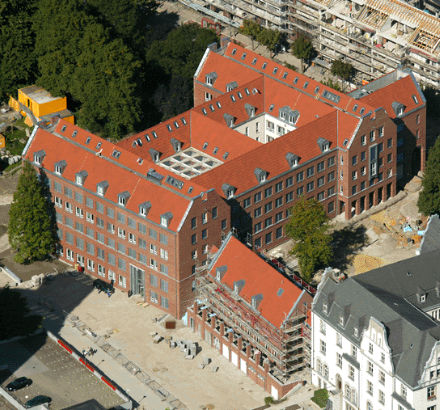
Elsewhere: Die Welt: Wie sich eine Stadt repariert (12 April 2007)
Im wunderschönen Monat Mai
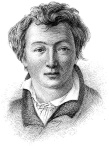
Als alle Knospen sprangen,
Da ist in meinem Herzen
Die Liebe aufgegangen.
Im wunderschönen Monat Mai,
Als alle Vögel sangen,
Da hab ich ihr gestanden
Mein Sehnen und Verlangen.
This poem by Heinrich Heine (I’m sure I need not tell you) is one of my favorites, and was famously set to music by Schumann. I had intended to post it to herald the beginning of May, but distractions got the better of me, so I am afraid it must herald the month’s departure.
The ‘Day of Fate’
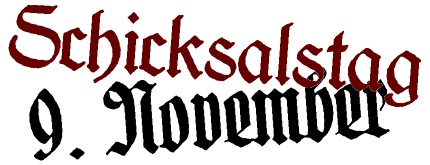
THE NINTH OF November is sometimes known in Germany as ‘Schicksalstag’ or the ‘Day of Fate’ owing to the series of events significant to modern German history which took place on the day in 1848, 1918, 1923, 1938, and 1989.
1918: Kaiser Wilhelm II is dethroned in the November Revolution, marking the end of the German monarchy.
1923: Hitler attempts his failed ‘Beer Hall Putsch’ which signficantly raises the profile of his tiny National Socialist German Workers’ Party.
1938: Synagogues and private property belonging to Jews are violently attacked in the ‘Kristallnacht’ pogrom.
1989: The politburo of Communist East Germany decides to relax the border-crossing restrictions between East and West Germany, leading to the fall of the Berlin Wall.
The first and last events (1848 and 1989) were encouraging events, while the three in between (1918, 1923, and 1938) were progressively worse. Indeed, it could easily be said that 1938 could not have happened without 1923, and that 1923 could not have happened without 1918, so these occurrences are not unrelated.
Birds of a Feather?
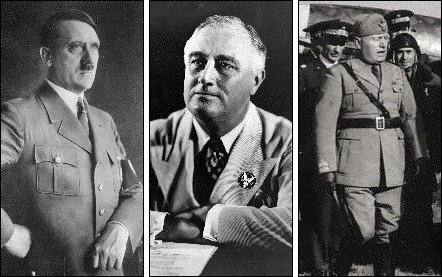
 Were Hitler, Roosevelt, and Mussolini really just different cuts of the same cloth? In a new book, Three New Deals: Reflections on Roosevelt’s America, Mussolini’s Italy, and Hitler’s Germany, 1933-1939, Wolfgang Schivelbusch makes precisely that argument. Interestingly, the National Socialists in Germany looked with fondness towards Roosevelt’s style of rule. The Nazi party newspaper Völkischer Beobachter actually praised “the adoption of National Socialist strains of thought in his economic and social policies” while Mussolini also saw a bit of himself in FDR. Roosevelt wouldn’t give the time of day to Herr Hitler but was actually quite fond of Signor Mussolini, calling him “that admirable Italian gentleman”.
Were Hitler, Roosevelt, and Mussolini really just different cuts of the same cloth? In a new book, Three New Deals: Reflections on Roosevelt’s America, Mussolini’s Italy, and Hitler’s Germany, 1933-1939, Wolfgang Schivelbusch makes precisely that argument. Interestingly, the National Socialists in Germany looked with fondness towards Roosevelt’s style of rule. The Nazi party newspaper Völkischer Beobachter actually praised “the adoption of National Socialist strains of thought in his economic and social policies” while Mussolini also saw a bit of himself in FDR. Roosevelt wouldn’t give the time of day to Herr Hitler but was actually quite fond of Signor Mussolini, calling him “that admirable Italian gentleman”.
That there were massive differences between the three is obvious. (Mussolini and Hitler came to the brink of war over Austria, and later they both had a war with Roosevelt). Nonetheless, the similarities are worth pointing out, and David Gordon has written a review of the book over at the Ludwig von Mises Institute. Give it a read.
‘We Stand By You’
Old Europe Lives?
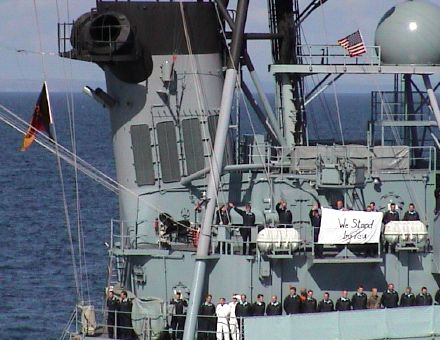
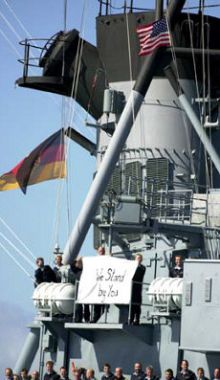 An incident took place at sea on September 14, 2001, just a few days after the attacks on New York and Washington, which has not been widely recounted. In the time leading up to September 11, the U.S.S. Winston S. Churchill was in port in Plymouth, England, where it was moored next to the Lütjens of the German Navy. During their time in port together, the officers and crews of the Churchill and the Lütjens had combined for a number of lively convivial undertakings in the generous spirit of friendship and brotherhood. After the attacks, however, Churchill immediately put to sea to perform a number of drills while maneuvering back in forth in the same area.
An incident took place at sea on September 14, 2001, just a few days after the attacks on New York and Washington, which has not been widely recounted. In the time leading up to September 11, the U.S.S. Winston S. Churchill was in port in Plymouth, England, where it was moored next to the Lütjens of the German Navy. During their time in port together, the officers and crews of the Churchill and the Lütjens had combined for a number of lively convivial undertakings in the generous spirit of friendship and brotherhood. After the attacks, however, Churchill immediately put to sea to perform a number of drills while maneuvering back in forth in the same area.
“It hasn’t been that fun I must confess,” an ensign aboard the Churchill wrote home, “and to be even more honest, a lot of people are frustrated at the fact that they either can’t be home, or we don’t have more direction right now. We have seen the articles and the photographs, and they are sickening. Being isolated as we are, I don’t think we appreciate the full scope of what is happening back home, but we are definitely feeling the effects.”
“About two hours ago the junior officers were called to the bridge to conduct Shiphandling drills. We were about to do a man overboard when we got a call from the Lutjens. […] Now at sea they called over on bridge-to-bridge, requesting to pass us close up on our port side, to say good-bye.”
“We prepared to render them honors on the bridgewing, and the Captain told the crew to come topside to wish them farewell. As they were making their approach, our Conning Officer announced through her binoculars that they were flying an American flag. As they came even closer, we saw that it was flying at half-mast. The bridgewing was crowded with people as the Boatswain’s Mate blew two whistles – Attention to Port – the ship came up alongside and we saw that the entire crew of the German ship were manning the rails, in their dress blues. They had made up a sign that was displayed on the side that read ‘We Stand By You’.”
As the ensign wrote later in the email, “It’s amazing to think that only a half-century ago things were quite different,” and it’s interesting to note that both ships are named after figures from the Second World War; Winston Churchill the half-American Prime Minister of Great Britain, and Günther Lütjens the admired German Admiral who died aboard the Bismarck.
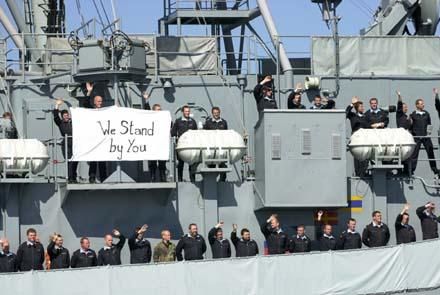
The Neue Galerie

 THE RECENT PURCHASE for the Neue Galerie of Gustav Klimt’s 1907 ‘Adele Bloch-Bauer I’ (above), alledgedly for a record-breaking price of $135,000,000, gives me the perfect opportunity to write a post on the eponymously recent addition to New York’s coterie of art museums. Since its 2001 opening, the Neue Galerie has resided in the handsome 1914 beaux-arts mansion on the corner of Fifth Avenue and 86th Street, designed by Carrère and Hastings (of New York Public Library fame) for industrialist William Starr Miller and later inhabited by Mrs. Cornelius Vanderbilt III. In the time since the construction of No. 1048, the rest of Fifth Avenue has undergone a lamentable transformation from a boulevard of beautiful townhouses and mansions to an avenue predominantly consisting of apartment buildings. While one appreciates the inoffensive design of the pre-war buildings on Fifth, there remain a number of thoroughly opprobrious modern interlopers which offend the graceful avenue. One can’t help but pine for Fifth Avenue before the mansions came down, but we can at least give thanks for holdouts like the Neue Galerie. (more…)
THE RECENT PURCHASE for the Neue Galerie of Gustav Klimt’s 1907 ‘Adele Bloch-Bauer I’ (above), alledgedly for a record-breaking price of $135,000,000, gives me the perfect opportunity to write a post on the eponymously recent addition to New York’s coterie of art museums. Since its 2001 opening, the Neue Galerie has resided in the handsome 1914 beaux-arts mansion on the corner of Fifth Avenue and 86th Street, designed by Carrère and Hastings (of New York Public Library fame) for industrialist William Starr Miller and later inhabited by Mrs. Cornelius Vanderbilt III. In the time since the construction of No. 1048, the rest of Fifth Avenue has undergone a lamentable transformation from a boulevard of beautiful townhouses and mansions to an avenue predominantly consisting of apartment buildings. While one appreciates the inoffensive design of the pre-war buildings on Fifth, there remain a number of thoroughly opprobrious modern interlopers which offend the graceful avenue. One can’t help but pine for Fifth Avenue before the mansions came down, but we can at least give thanks for holdouts like the Neue Galerie. (more…)
Stauffenberg’s Arms
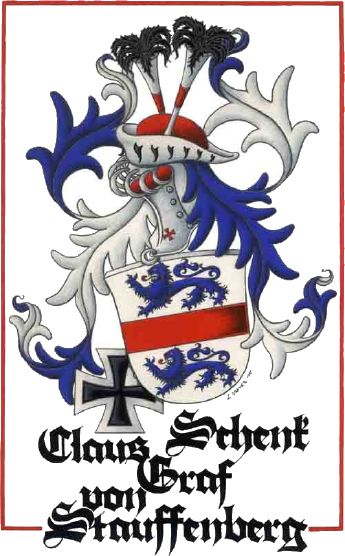
Hommage à la mémoire de Claus Philip Maria Schenk comte von Stauffenberg, homme d’honneur et de foi, qui participa à l’attentat contre Hitler, le 20 juillet 1944 dans le cadre du plan ‘Walkyrie’ destiné à renverser le régime nazi.
The arms of Claus Philipp Maria Schenk Count von Stauffenberg, beautifully depicted by the French heraldic artist Laurent Granier.

Previously: Long Live Our Holy Germany!
Words of Wisdom
I’d like to thank Field Marshal Rommel for vindicating my life.
The Two Germanies
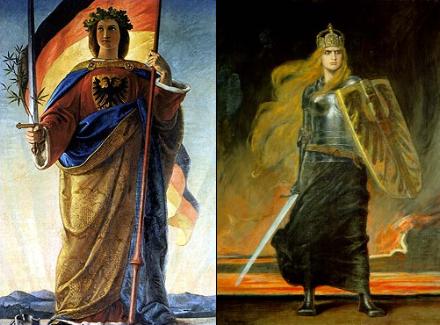
A recent post by Aelianus entitled The Two Germanies brought to mind a little-known idea which surfaced towards the end of World War II. I read in the biography of Empress Zita that a plan was hatched to divide what we now know as Germany, combining Bavaria and Austria to create a Catholic state under the restored Hapsburgs and leaving northern Germany to be a Protestant kingdom with, odd as it might perhaps seem, Lord Louis Mountbatten. Of course it’s not really that odd when one considers that the real name of the Mountbatten family is Battenberg, changed to disguise their Teutonicity during the Great War when the fervor of hatred against our cousin the Hun ran willy-nilly. While Mountbatten was born in Windosr Castle and served as First Sea Lord as well as the final Viceroy of India, he was really entirely German in terms of ancestry. His parents were Prince Louis of Battenberg and Princess Victoria of Hesse and the Rhine, while Louis IV, Grand Duke of Hesse and the Rhine was his grandfather. By right, he was His Serene Highness Prince Louis of Battenberg, but cherishing their adopted country, the family were intimidated into dropping all German styles and titles in 1917.
Lord Mountbatten apparently took the proposal seriously enough that he began to brush up on his German, and informed Empress Zita, living in exile in the Dominion of Canada during the Second World War, of its prospects for both their families. Of course, with Yalta, nothing was ever to come of it and the closest Lord Mountbatten ever came to power, aside from his reign as Viceroy of India, was in 1967 when he was alledgedly asked to lead a coup overthrowing the Labour government. Mountbatten was highly reluctant, and nothing came of the plot. In 1979, while summering at his usual holiday home in the Irish Republic, Mountbatten was killed by an IRA bomb, along with the Dowager Lady Brabourne (aged 82), the Hon. Nicholas Knatchbull (aged 14), and Paul Maxwell (aged 15), a local boy working on the Mountbatten’s boat. He was a Knight of the Garter, a Knight Grand Cross of Bath, Order of Merit, Knight Grand Cross of the Star of India, Knight Grand Cross of the Indian Empire, Knight Grand Cross of the Royal Victorian Order, and the Distinguished Service Order.
Bill and Ted
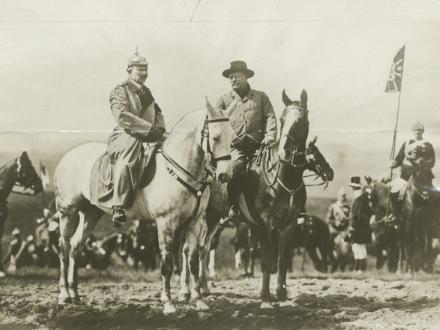
His Imperial Majesty Wilhelm II, the German Emperor, and His Excellency Mr. Theodore Roosevelt, President of the United States of America.
What To Do When You Find a Hohenzollern in Your Study

The man of letters, of course, needs a place in which to withdraw from his various dalliances in the social realm and to concentrate on the dominion of learning; a private place in which to enjoy a book, broadsheet or other periodical, or perhaps to brood in a comfortable chair with a dram of scotch and some sound music. The ladyfolk, needless to say, have no place in such a bailiwick, not even to clean, for the wise gentleman knows that a study which accumulates in dust likewise accumulates in a certain intangible value. After all, what man of letters does not relish in removing his 1928 Burns and Oates edition of Martyrs of the Upper Volta from the shelves, blowing the dust from the cover, and charging inwards to read of some blessed soul who met his end in a steamy cauldron?
What then could throw arcadian bliss into disarray quite as much as the sudden appearance of Kaiser Wilhelm? A Hapsburg? You may as well have invited! A Bourbon? Well, fair enough, they have been known to lose their heads. But a Hohenzollern? You’ve got your work cut out for you.
Once considered the seminal work on dealing with Spontaneous Hohenzollern Appearances (or ‘SHA’), Dr. Leo von Fulbreck’s Treatise on the Treatment of Hohenzollernitosicity (to use the old, politically-incorrect term for SHA), has since been discredited, perhaps unjustly due to the Sparticist leanings of the Thuringian professor. The 1919 U.S. War Department guide War Department Field Guide 24-R: Recommended Courses of Action in Event of Hohenzollern Situation (and its appendix 24-R(II) dealing with the Hohenzollern-Sigmaringen branch) perpetuated the essence of von Fulbreck’s theories shorn of their ideological slant. The Second-World-War-era Your Enemy: the Sudden Hun-henzollern released by the British Department of Information, however, is generally considered unreliable. Combing through all this mess, I have endeavoured to deliver as part of my contribution to learning the most well-researched, as well as concise, recommended course of action regarding the spontaneous appearence of Hohenzollerns in one’s study:
1. Give the man a stern, intense, but unprovocative stare (as exemplified in above illustration) and he will eventually be moved to tears, mourning the loss of Tanganyika.
2. Simultaneously ring the bell (or, if one’s home is electrically-equipped, press the buzzer) and ask one of your staff to contact the Doorn Home for the Dethroned and Bewildered to inform them that one of their patients is on the loose.
3. Offer a stiff drink and wait for the men from the Doorn Home to arrive.
With any luck that should suffice, and unfortunate mishaps will hopefully be avoided.
Cappa Magna Sighting
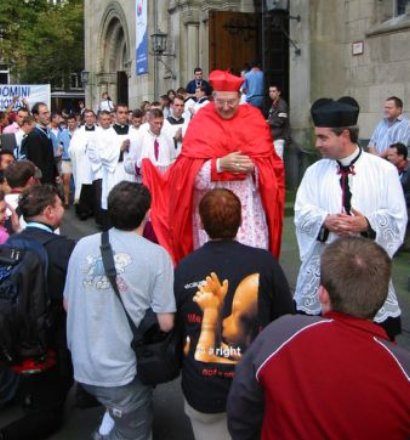
His Eminence George Cardinal Pell, the Archbishop of Sydney, happily donned the traditional (and these days rarely seen) cappa magna during his presence amongst the Juventutem pilgrims at the recent World Youth Day in Germany. His Eminence, known for his Australian candor, is seen above blessing young folks outside the Düsseldorf church designated for the use of the Juventutem traditional Catholic youth.
The Catholic Encyclopedia informs us that the “great cope” is not a liturgical vestment per se but rather a glorified version of the cappa choralis (choir cope), and is reserved for cardinals, bishops, and certain privileged prelates.
Photos from the FSSP.
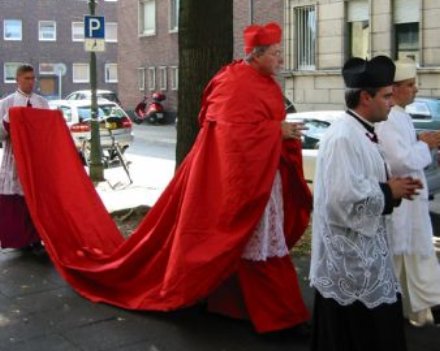
Films Recently Viewed
| The Life and Death of Colonel Blimp 1943 Directed by Michael Powell and Emeric Pressburger. A fine film, worth seeing. I’ve spied a few Blimps-in-training at the Mess in Wyvern. Also, Theo Kretschmar-Schuldorff is a heck of a good name for a character. |
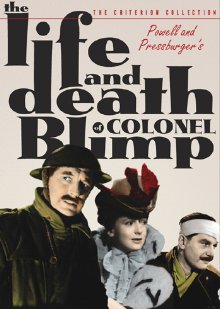 |
| La Grande Illusion 1937 Directed by Jean Renoir. I enjoyed this film greatly. It made me wish I had been a WWI pilot shot down by the Huns just so I could be invited to luncheon with the German officers. Everyone comported themselves well in those days (or at least in the cinema version of those days). According to IMDB, the Viennese Erich von Stroheim had spent so much time in America that he could barely speak German when the film was made. |
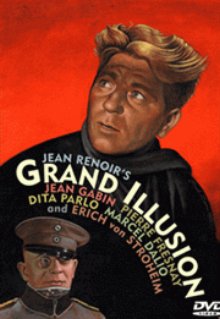
|
| The Birth of a Nation 1915 Directed by D.W. Griffith. Disturbing. The film’s basic premise that the United States was forged as a nation by the white knights of the Ku Klux Klan is balderdash, pure and simple. Still, a powerful and remarkable propaganda film. “It is like writing history with lightning, and my only regret is that it is all so terribly true,” said Woodrow Wilson, whose Southern racism most modern liberals like to ignore. |
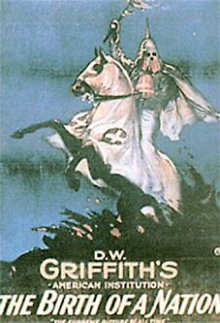
|
| Alexander Nevsky 1938 Directed by Sergei M. Eisenstein, score by Sergei Prokofiev. More brilliant propaganda, this time for the USSR, not the KKK. Beautifully shot, but the battle scene is a tad too long. Though very nationalistic, it is not hard to see the communism behind the film in a number of scenes. Found the only slightly veiled swastikas on the mitre of the Teutonic bishop rather droll. |
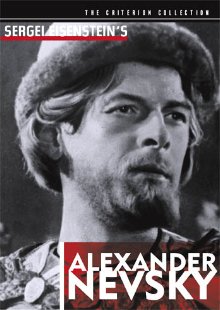
|
| The Battle of Algiers 1965 Directed by Gillo Pontecorvo, score by Ennio Morricone. My second viewing of this splendid film. Colonel Mathieu: “There are 80,000 Arabs in the Casbah. Are they all against us? We know they’re not. In reality, it’s only a small minority that dominates with terror and violence. That minority is our adversary; we must isolate it and destroy it.” And they did. Still managed to lose Algeria though – which was a damn shame for the Algerians. |

|
Long Live Our Holy Germany!
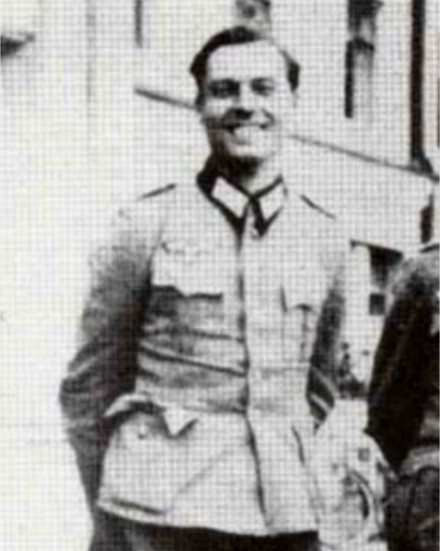
It was July 20, 1944, sixty years ago today, that Col. Claus Schenk Graf von Stauffenberg was executed for his masterminding the plot to kill Adolf Hitler. Stauffenberg was a devout Catholic who became convinced that Hitler was an Antichrist.
“Fate has offered us this opportunity, and I would not refuse it for anything in the world. I have examined myself before God and my conscience. It must be done because this man is evil personified.”
His uncle, Graf (Count) Nikolaus von Üxküll, recruited him into the resistance movement after the Polish campaign in 1939. After a series of missed opportunities, Stauffenberg finally placed a bomb to kill Hitler. Unfortunately, it was moved to the other side of a strong oak table supporter, shielding Hitler from the full force of the blast. Claus Philip Maria Shenck Graf von Stauffenberg was shot by the Gestapo at half past midnight that same evening.
His dying words were “Es lebe unser heiliges Deutschland!” – Long live our holy Germany.

Search
Instagram: @andcusack
Click here for my Instagram photos.Most Recent Posts
- Articles of Note: 11 November 2024 November 11, 2024
- Why do you read? November 5, 2024
- India November 4, 2024
- The Lithe Efficiency of the Old Constitution November 4, 2024
- Waarburg October 2, 2024
Most Recent Comments
Book Wishlist
Monthly Archives
Categories

